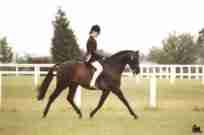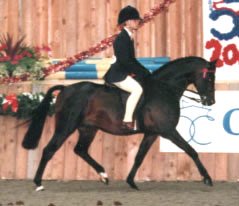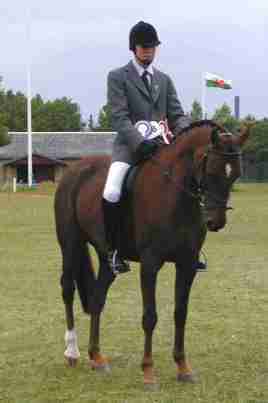Just bought a pony
and not sure which classes it would suit? Try this page it is a great guide
and might help you to decide!
This information is
based on the rules of the show pony society. Please check your class rules
for unaffiliated shows as they may differ. Remember their classes may not
be as strict, but this is a great guideline.

LEADING-REIN PONIES
(Pony not to exceed 12 hands. Riders 7 years or under. May be divided into
11.2 and under, and not exceeding 12hh section.)
If possible try to
match your pony to your child s build and size. Putting very small, slim
children on large ponies may look
Good in Thelwell books but will lose you points on suitability section. Try
to put a small child on a dainty, narrow pony, which will probably have Dartmoor
or Welsh bloodlines. It should be pretty and move with smooth, comfortable
gaits. Extravagant fast action in this type can upset or dislodge a tiny rider.
A large child will need a bigger pony; if the child also has long legs a wider
pony will be an advantage. It does not look nice if the child s stirrups
are on level with the pony s knees.
A tiny child is not expected to be much more than a passenger enjoying the
ride, but an older child should be a little more competent, and the pony must
respond to his rider s aids. Some judges ask the rider to dismount and
lead the pony, so they can see if it is suitable for a child to handle. The
larger child may be expected to mount unaided and show how patient the pony
is. Consider all these points when selecting a lead rein pony!
The ideal leading rein pony should be perfectly tailored to it s rider,
willing not a slug, well mannered, obedient, beautiful, relaxed and full of
confidence.

FIRST RIDDEN PONIES
(Pony not to exceed 12 hds, rider 9 years or under)
As in the previous
class suitability is a first consideration. Not all lead rein ponies will
also be good first ridden ponies.
As the child will be unaccompanied in the ring the temperament and schooling
are very important.
Do not be tempted to over mount your child just to fill the judge s
eye. A good little pony is every bit as good as his larger counterpart, especially
in view of the younger, smaller, less experienced child that may be aboard.
The first ridden pony will be and look safe, conveying a confidence giving
air, which befits a pony giving his child a first taste of
Riding alone. An elegant little pony, teeming with quality, and obviously
looking for trouble just will not do.
He will show obvious signs of native blood or may be full native.
The judge s are
looking for a nice looking pony, showing plenty of native blood, not a slug
but also not too sharp,
That does willingly everything his rider asks and nothing more. The child
must be in control and be seen asking for things not just steering an over-keen
pony that anticipates by itself what is coming next and is always one step
ahead of its jockey. The pony that hangs back slightly will make a better
first ridden. A really good first ridden pony is one of the most difficult
to find.

RIDING PONY
(Not exceeding 12.2hands, riders 12 years or under)
Most 11 and 12 year olds are too large for a 12.2 pony, so if your rider is
tall the best advice is to skip straight to the 13.2
Class rather than jeopardize your chances with an unsuitable combination.
Once you reach the 12.2 class, you are in the realm of the riding pony, so
the chubby little native pony just will not do. Nevertheless, it is generally
agreed that he should show more native blood than his larger counterpart.
He should, though, show far more quality and be much more free-going than
a first pony, he will also be finer.
The 12.2 is expected to give a far more sophisticated display than the first
pony and this can include a gallop. It stands to reason that manners are high
on the list of requirements in this class. The judge might forgive a tiny
bit of exuberance in the 14.2 with which the older, more experienced child
should be able to cope, it will not be forgiven in the 12.2 because of his
younger rider.

RIDING PONY
(Exceeding 12.2 hands not exceeding 13.2hands, rider14 years or under.)
The 13.2 class often contains the finest examples of the riding pony. At this
height the exhibits are usually large enough to fill the eye, they and their
jockeys are capable of giving a polished and sophisticated display, they are
full of quality and elegance, yet they are small enough to retain their pony
character. Even in this class, the combination aspect should not be ignored,
as a very small or over large rider can present an unbalanced picture to the
judge.
RIDING PONY
(Exceeding 13.2 hands not exceeding 14.2 hands, riders 16 years or under.)
It is really difficult to find a good type of 14.2 pony, because so many are
hack or hunterish. It is essential that the 14.2 exhibit show true pony character.
One often hears people saying that the modern riding pony should resemble
a miniature hack, but there is one all important difference and that is pony
quality. No judge would want to see obvious pony blood in a hack and it is
just as important that the riding pony judge should recognize that a miniature
hack without pony blood should not be able to win a pony class.
As befits a larger pony suitable for a teenager to ride, the 14.2 should be
free going, bold, and a balanced ride. He should show that he is well able
to gallop and satisfy the demands of his more experienced rider. He should
remain calm, well mannered and obedient. He should not hot up or look like
he lacks enthusiasm. Of all the ridden ponies the 14.2 should be the one the
judge would most like to ride.
NOVICE PONY
The classification is usually the same as the other pony classes. Three-year-old
ponies can be registered after 1st of June and may be shown after the 1st
of July. The definition of a novice is not having won a prize of five pounds
or over at an affiliated show. Thus a pony that has not won this at 1st of
October 1999 is eligible as a novice until 30th September 2000 regardless
of how many novice classes it may win.
RIDING PONY
(Exceeding 14hds, not exceeding 15 hands, riders 18 years or under.)
In 1969 the BSPS introduced a new class for animals exceeding 15hds. This
was seen as a stepping-stone to assist young riders making the transition
from pony to hack or hunter show classes. It has proved very popular, providing
a niche for the overgrown pony or the undersized hack that can still show
some pony quality.

WORKING HUNTER PONIES
(UP TO 15 HANDS)
The working hunter pony needs to be bold and free going, but an excitable
temperament is undesirable because the perfect hunting pony should never hot
up. It is just as important that the pony should enjoy jumping and even if
the pony is novice and unshown, the prospective purchaser should ask to see
him over some fences. Rushing and over enthusiasm van be corrected in a young
pony, but never buy a pony that jumps reluctantly, refuses or runs out. An
experienced person can school or force a horse to jump, but you cannot
make him enjoy it and this will always show in his performance.
The working hunter pony can be a straight cross between the riding pony and
a native breed, a native crossed with a small hunter type, a riding pony of
a more substantial type or a pure native. It is the type that is most important
not the breed. He needs to be clever, willing, bold and agile, as well as
kind, free-moving, beautiful, fast and substantial. The ideal working hunter
pony has the looks and substance of a small hunter, the performance of a working
hunter and the size of a quality pony.
The main criterion is that he should be a suitable animal to carry a child
in the hunting field. He should be schooled and obedient and his paces should
be straight, sound and correct. He should not have the extravagant paces of
the show pony, but his gaits should be long, level and smooth, choppy action
is not desired in a hunter pony. Conformation wise he will be heavier than
the show pony in every way. He will have more bone and substance, a plainer
head and have a more workman like appearance and action. He should not be
pretty but must not be coarse. He must be handsome and personable because
if he is to be truly successful he must have the quality and presence to set
him above the crowd.

SHOW HUNTER PONIES
(Classification as in working hunter ponies.)
What the judges are looking for in these classes are miniature hunters with
pony quality. One needs to get in one s eye by watching the
open hunter classes, to develop an ability to scale down one s requirements
without losing the performance and manner of going, and pony quality is important,
never more so than in the largest height class. The ponies should be ridden,
not like show ponies, but like show hunters, they should gallop well, be bold
but biddable.
|







